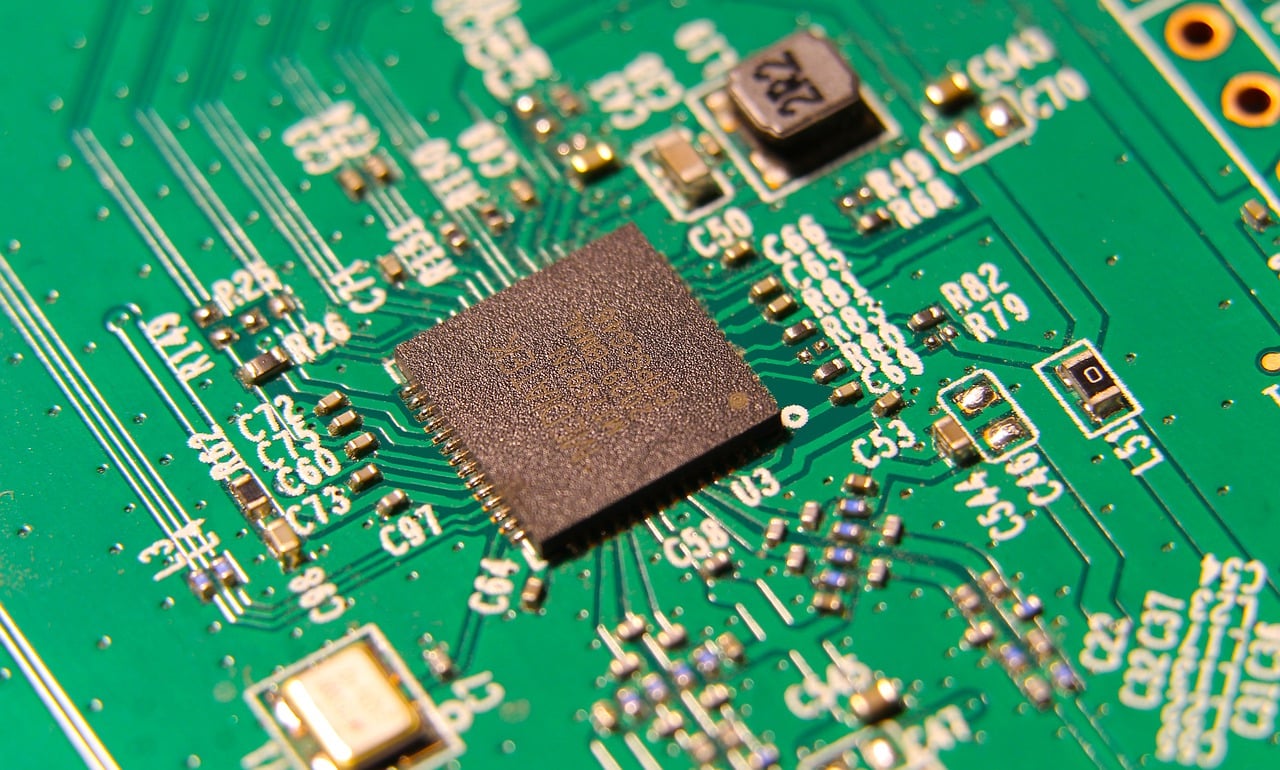Exploring Cross-Chain Technology - Future of Blockchain?
In the ever-evolving world of blockchain, one of the most exciting developments is cross-chain technology. Imagine a world where different blockchain networks can communicate seamlessly, much like how we use our smartphones to connect with various apps and services without a hitch. This article dives deep into the concept of cross-chain technology, exploring its significance in the blockchain ecosystem and how it shapes the future of decentralized applications and interoperability among various blockchain networks.
So, what exactly is cross-chain technology? At its core, it allows different blockchain networks to interact and share information. Think of it as a universal translator for blockchains, breaking down the barriers that often keep these networks isolated. The necessity for cross-chain solutions has never been more apparent, especially as the number of blockchain projects continues to grow exponentially. Without a way to connect these networks, we risk creating a fragmented ecosystem where assets and information remain trapped within their respective silos.
Cross-chain solutions come with a plethora of advantages that can significantly enhance the blockchain landscape. Here are some of the key benefits:
- Enhanced Interoperability: This is crucial for the seamless exchange of data and assets across different blockchains.
- Improved Scalability: By allowing multiple blockchains to work together, we can handle more transactions and users without compromising performance.
- Increased Liquidity: Cross-chain technology allows assets to move freely between networks, creating a more liquid market.
These benefits are not just theoretical; they contribute to the growth and adoption of blockchain technology across various industries, from finance to supply chain management.
Interoperability is the beating heart of cross-chain technology. It's what enables different systems to work together, much like how different apps on your phone can share data seamlessly. In the world of decentralized finance (DeFi), this means users can effortlessly exchange assets between different platforms, enhancing their trading experience. Imagine being able to swap tokens from one blockchain to another without the cumbersome process of converting them to fiat first. Cross-chain technology facilitates this connectivity, making it a game-changer for the DeFi landscape.
Bridging different blockchains is akin to building bridges over rivers that separate communities. These bridges allow for the transfer of assets and information, creating a more cohesive ecosystem. The mechanisms behind these bridges often involve smart contracts that ensure secure and reliable transactions between networks. As we analyze these systems, it's clear that they play a significant role in fostering collaboration among various blockchain networks, paving the way for a more integrated digital economy.
The impact of cross-chain technology on DeFi platforms cannot be overstated. By enabling users to access a broader range of assets and services, cross-chain solutions enhance the overall functionality and user experience of DeFi applications. For instance, a user could leverage a lending platform on one blockchain while using collateral from another, maximizing their investment opportunities. This integration not only boosts user engagement but also drives innovation in the DeFi space.
Despite its immense potential, cross-chain technology is not without its challenges. Security concerns and technical complexities often loom large over its implementation. For example, if a bridge between two blockchains is compromised, it could lead to significant losses for users. Additionally, the technical intricacies involved in ensuring smooth communication between different protocols can be daunting. However, ongoing efforts within the blockchain community are focused on addressing these hurdles effectively, aiming to create a safer and more robust cross-chain environment.
The future of cross-chain technology looks incredibly promising. As it continues to evolve, we can expect to see emerging trends and potential advancements that will revolutionize how blockchains interact. This evolution is not just about improving existing systems; it’s about creating entirely new paradigms for decentralized applications and services.
Innovations in cross-chain technology are expected to drive further adoption and integration. Upcoming technologies, such as layer-2 solutions and advanced interoperability protocols, could redefine how blockchains function together. These advancements will not only enhance performance but also improve user experiences, making blockchain technology more accessible to the average person.
Cross-chain technology is pivotal in accelerating blockchain adoption across various sectors. Its potential impact on industries such as finance, supply chain, and healthcare is profound. For instance, in the supply chain industry, cross-chain solutions can enable real-time tracking of goods across different networks, ensuring transparency and efficiency. Similarly, in healthcare, patient data can be securely shared across institutions, improving care and outcomes. As these industries begin to embrace cross-chain technology, we are likely to witness a more interconnected digital economy that benefits everyone.
- What is cross-chain technology? Cross-chain technology allows different blockchain networks to communicate and share information, enhancing interoperability.
- Why is interoperability important? Interoperability is crucial for the seamless exchange of data and assets, enabling a more integrated blockchain ecosystem.
- What are the challenges of cross-chain technology? Key challenges include security concerns and technical complexities that can hinder implementation.
- How will cross-chain technology impact industries? It will accelerate blockchain adoption and improve efficiency across various sectors, such as finance and supply chain.

Understanding Cross-Chain Technology
Cross-chain technology is a groundbreaking concept that allows different blockchain networks to communicate and interact with one another. Imagine a world where various digital currencies, smart contracts, and decentralized applications (dApps) can seamlessly exchange data and assets without being confined to their own individual chains. This is the essence of cross-chain technology—it breaks down the silos that exist within the blockchain ecosystem, creating a more interconnected and efficient landscape.
At its core, cross-chain technology operates on a few fundamental principles. First, it emphasizes interoperability, which is the ability for different systems to work together. In the blockchain world, this means enabling various networks to share information and assets securely. Second, it focuses on scalability, allowing networks to expand their capabilities by leveraging the strengths of other blockchains. Finally, it promotes decentralization, ensuring that no single entity has control over the entire ecosystem, which is a key principle of blockchain technology.
The necessity of cross-chain solutions in today's blockchain landscape cannot be overstated. As the number of blockchain networks continues to grow, the need for these networks to interact becomes increasingly critical. Without cross-chain technology, users would be limited to the functionalities of a single blockchain, which could stifle innovation and reduce the overall utility of blockchain applications. In a way, cross-chain technology acts as the glue that holds the diverse blockchain ecosystem together, enabling a more robust and versatile environment for developers and users alike.
To illustrate the importance of cross-chain technology, consider the following key points:
- Enhanced Collaboration: Cross-chain solutions foster collaboration among different blockchain networks, allowing them to work together towards common goals.
- Broader Access to Resources: Users can tap into a wider array of assets and services, enhancing their overall experience.
- Increased Innovation: By allowing different blockchains to communicate, cross-chain technology encourages the development of new applications and services that can leverage multiple networks.
In summary, understanding cross-chain technology is essential for anyone looking to grasp the future of blockchain. As we continue to explore its implications, we can see that it holds the key to unlocking the full potential of decentralized applications and creating a more interconnected digital economy.

Benefits of Cross-Chain Solutions
Cross-chain solutions are like the magic glue that holds the diverse world of blockchain together. Imagine a bustling marketplace where different vendors sell unique products. Each vendor represents a different blockchain, and without a way to communicate, shoppers (users) would be limited to only one vendor's offerings. Cross-chain technology breaks down these barriers, enabling seamless interactions and transactions across various blockchain networks. This is not just a convenience; it’s a game-changer for the entire ecosystem.
One of the most significant benefits of cross-chain solutions is enhanced interoperability. With the rise of numerous blockchain platforms, the ability for these networks to communicate with each other is crucial. Cross-chain technology allows assets and data to flow freely between different blockchains, creating a more cohesive and integrated environment. This interoperability is essential for decentralized applications (dApps) that require data from multiple sources to function effectively. Think of it as a universal translator that allows different languages to be understood by everyone.
Another key advantage is the improved scalability that cross-chain solutions provide. As the demand for blockchain technology grows, so does the need for systems that can handle a larger volume of transactions. By enabling blockchains to share the load, cross-chain technology can significantly reduce congestion on individual networks. This collaborative approach not only speeds up transaction times but also enhances the overall user experience. Imagine trying to get through a crowded subway station; if there are multiple exits (blockchains), it’s much easier to get where you need to go!
Moreover, cross-chain solutions lead to increased liquidity. In traditional finance, liquidity refers to how easily assets can be bought or sold without affecting their price. In the blockchain world, liquidity becomes even more vital as it allows users to access a wider array of assets across different platforms. This means that users can trade assets on one blockchain while leveraging the benefits of another, facilitating more dynamic trading environments. For instance, a user might want to swap a token from one blockchain for another without the hassle of transferring it to a centralized exchange first.
To sum it up, the benefits of cross-chain solutions can be viewed through the following lens:
- Interoperability: Seamless communication between different blockchains.
- Scalability: Enhanced capacity to handle more transactions by distributing workloads.
- Liquidity: Greater access to diverse assets, promoting a more active trading environment.
As we look towards the future, it’s clear that cross-chain technology will play a pivotal role in shaping the blockchain landscape. By fostering collaboration among various networks, it not only enhances the user experience but also paves the way for innovative solutions that can tackle existing challenges in the blockchain ecosystem. The integration of different blockchains will lead to a more robust and versatile digital economy, where users can enjoy the best of what each platform has to offer.
What is cross-chain technology?
Cross-chain technology refers to the ability of different blockchain networks to communicate and share information with one another, allowing for seamless transactions and interactions.
Why is interoperability important?
Interoperability is crucial as it enables various blockchains to work together, enhancing the overall functionality and user experience of decentralized applications.
How does cross-chain technology improve scalability?
By allowing multiple blockchains to share the processing load, cross-chain technology can handle more transactions simultaneously, reducing congestion and improving transaction speeds.
What are the implications of increased liquidity?
Increased liquidity allows users to access a broader range of assets and facilitates more efficient trading, making it easier to buy or sell assets without affecting their market price.

Interoperability Enhancement
Interoperability is the backbone of effective communication between different blockchain networks. Imagine trying to have a conversation with someone who speaks a completely different language; it would be nearly impossible to share ideas or collaborate. This is the challenge that cross-chain technology addresses in the world of blockchain. By enabling various blockchains to interact seamlessly, it paves the way for a more interconnected ecosystem where assets and information can flow freely.
One of the primary ways cross-chain technology enhances interoperability is through the use of atomic swaps. These are smart contracts that allow for the exchange of cryptocurrencies from different blockchains without the need for a centralized intermediary. Think of it as a direct trade between two parties, where both sides can see the transaction occurring in real-time, ensuring transparency and trust. This not only simplifies the process but also reduces the risk of fraud or miscommunication.
Additionally, cross-chain bridges play a crucial role in this interoperability enhancement. These bridges act as conduits between different blockchain networks, allowing users to transfer assets across them. For example, if you want to move your Bitcoin to a platform that operates on Ethereum, a cross-chain bridge can facilitate that transfer without requiring you to sell your Bitcoin first. This process not only saves time but also provides users with the flexibility to utilize their assets across various platforms.
The implications of enhanced interoperability are significant, particularly in the realm of Decentralized Finance (DeFi). With cross-chain solutions in place, users gain access to a wider array of financial services and products. They can leverage liquidity from multiple sources, participate in yield farming across different platforms, and even explore new investment opportunities that were previously inaccessible. This interconnectedness fosters a richer and more diverse financial ecosystem, where innovation can thrive.
As we look ahead, it's essential to recognize that the journey toward full interoperability is ongoing. While the advancements in cross-chain technology are impressive, challenges remain. Issues such as security vulnerabilities and the complexity of integrating different protocols must be addressed. However, with continuous innovation and collaboration among developers, the dream of a fully interoperable blockchain landscape is becoming increasingly attainable.
In summary, interoperability enhancement through cross-chain technology is not just a technical upgrade; it's a transformative shift that will redefine how we interact with digital assets. As this technology evolves, it promises to unlock new possibilities and drive the adoption of blockchain across various sectors, making it an exciting time to be part of this digital revolution.
- What is cross-chain technology? Cross-chain technology allows different blockchain networks to communicate and interact with one another, enabling seamless asset and data exchange.
- Why is interoperability important in blockchain? Interoperability enhances the efficiency of transactions, allows for greater access to diverse financial services, and fosters innovation across the blockchain ecosystem.
- How do atomic swaps work? Atomic swaps are smart contracts that facilitate direct exchanges of cryptocurrencies between different blockchains without the need for intermediaries.
- What role do cross-chain bridges play? Cross-chain bridges connect different blockchains, allowing users to transfer assets seamlessly between them, enhancing liquidity and usability.

Bridging Different Blockchains
Bridging different blockchains is akin to building bridges between islands in an archipelago. Each island represents a unique blockchain, with its own set of rules, currencies, and functionalities. Without bridges, these islands remain isolated, limiting the potential for collaboration and innovation. Cross-chain technology serves as these vital bridges, enabling the transfer of assets and information seamlessly across various blockchain networks.
The mechanisms behind these bridges can be complex, often involving protocols that facilitate communication and data exchange. For instance, atomic swaps allow users to trade assets between different blockchains without the need for an intermediary. Think of it as a peer-to-peer exchange where two parties can directly swap their goods without relying on a third party. This not only enhances security but also reduces transaction costs, making it an attractive option for users.
Moreover, the significance of these bridges stretches beyond mere asset transfers. They foster collaboration among diverse blockchain ecosystems, encouraging developers to create decentralized applications (dApps) that leverage the strengths of multiple networks. For example, a dApp could utilize the speed of one blockchain while tapping into the security features of another. This synergy can lead to innovative solutions that address real-world problems, from supply chain transparency to financial inclusivity.
However, it’s essential to acknowledge that bridging different blockchains is not without its challenges. Security concerns arise, as transferring assets across networks can expose vulnerabilities. Additionally, the technical complexities involved in ensuring smooth interoperability can be daunting. Developers must navigate these hurdles to create robust and reliable cross-chain solutions that users can trust.
In conclusion, bridging different blockchains is a fundamental aspect of the evolving blockchain landscape. As these bridges become more sophisticated, they will unlock new possibilities for collaboration and innovation, ultimately shaping a more interconnected digital economy. The future is bright for cross-chain technology, and its potential to revolutionize how we interact with blockchain networks is just beginning to unfold.
- What is cross-chain technology? Cross-chain technology enables different blockchain networks to communicate and interact, allowing for the transfer of assets and data.
- Why are bridges important in blockchain? Bridges facilitate interoperability, allowing various blockchains to work together, enhancing the overall functionality and user experience.
- What are atomic swaps? Atomic swaps are a method of exchanging cryptocurrencies between different blockchains without needing a centralized exchange.
- What challenges do cross-chain solutions face? Security concerns and technical complexities are among the primary challenges in implementing effective cross-chain solutions.
- How does cross-chain technology impact decentralized finance (DeFi)? Cross-chain technology allows DeFi platforms to access a broader range of assets and services, enhancing user experiences and functionalities.

Decentralized Finance (DeFi) Integration
Decentralized Finance, commonly known as DeFi, has emerged as a revolutionary force in the blockchain space, and its integration with cross-chain technology is nothing short of a game-changer. Imagine a world where you can seamlessly access a plethora of financial services across different blockchain networks without the need for intermediaries. That's the magic that cross-chain solutions bring to the DeFi landscape. By enabling various blockchains to communicate, cross-chain technology allows users to leverage the unique features and assets of multiple platforms, creating a more dynamic and inclusive financial ecosystem.
One of the most exciting aspects of this integration is the ability to transfer assets across different DeFi platforms. For instance, a user can take advantage of the best lending rates on one blockchain while simultaneously utilizing liquidity pools on another. This kind of flexibility not only enhances user experience but also fosters a competitive environment where platforms strive to offer better services. Think of it as having a universal remote that can control multiple devices; you’re no longer limited to just one brand or model.
Moreover, cross-chain technology significantly improves liquidity in the DeFi space. With various assets and tokens flowing freely between blockchains, users can access a wider range of financial products. This increased liquidity can lead to better price discovery, reduced slippage, and ultimately, a more efficient market. To illustrate this point, consider the following table that highlights how cross-chain integrations can enhance liquidity:
| Feature | Traditional Finance | DeFi with Cross-Chain Integration |
|---|---|---|
| Asset Accessibility | Limited to specific platforms | Broad access across multiple blockchains |
| Market Liquidity | Often fragmented | Enhanced through cross-chain transactions |
| Transaction Speed | Can be slow due to intermediaries | Faster transactions with direct access |
Additionally, the integration of cross-chain technology in DeFi opens up new avenues for innovative financial products. Users can engage in yield farming, liquidity mining, and even cross-chain arbitrage with ease. This creates a vibrant ecosystem where creativity knows no bounds. Imagine being able to earn interest on your assets while simultaneously trading them on different platforms, all without the hassle of cumbersome transfers or waiting periods.
However, it’s essential to acknowledge that while the benefits are compelling, there are challenges that come with this integration. Security remains a primary concern, as bridging assets between chains can expose users to risks. As the DeFi space continues to grow, developers are actively working to implement robust security measures to protect users. The future of DeFi with cross-chain technology is bright, but it requires a collective effort to ensure a safe and reliable environment for all participants.
In conclusion, the integration of decentralized finance with cross-chain technology is paving the way for a more inclusive and efficient financial system. By breaking down barriers between blockchains, users can enjoy enhanced liquidity, innovative financial products, and a seamless experience that transcends traditional finance. As we continue to explore this exciting frontier, one thing is clear: the future of finance is decentralized, interconnected, and full of potential.
- What is DeFi? - DeFi stands for Decentralized Finance, a movement that aims to recreate traditional financial systems using blockchain technology.
- How does cross-chain technology work? - It allows different blockchain networks to communicate and share information, enabling seamless transactions across platforms.
- What are the benefits of integrating DeFi with cross-chain technology? - It enhances liquidity, improves asset accessibility, and fosters innovation in financial products.
- Are there risks associated with cross-chain DeFi? - Yes, security concerns are prevalent, but ongoing developments aim to mitigate these risks.

Challenges of Cross-Chain Implementation
While cross-chain technology holds incredible potential, it’s not without its share of challenges. One of the most pressing issues is security. When different blockchain networks communicate, they create multiple points of vulnerability. If one network is compromised, it could potentially jeopardize the integrity of transactions across all connected chains. This is akin to having a chain where one weak link can cause the entire system to fail. Developers and stakeholders must ensure robust security protocols are in place to protect against such risks.
Another significant hurdle is technical complexity. Building bridges between different blockchains requires a deep understanding of various protocols, consensus mechanisms, and data structures. This complexity can lead to increased development time and costs. Moreover, the lack of standardized solutions can make integration cumbersome. Imagine trying to fit pieces of a jigsaw puzzle together when they were designed for different puzzles altogether; it requires creativity and effort to make them work.
Additionally, regulatory uncertainty poses a challenge for cross-chain implementations. As governments around the world grapple with how to regulate blockchain technology, the lack of clear guidelines can hinder innovation. Developers may hesitate to invest in cross-chain solutions if they are unsure about the legal implications. This uncertainty can stifle creativity and slow down the adoption of these transformative technologies.
Furthermore, network latency can also be a concern. When assets and data are transferred between blockchains, the time it takes for these transactions to be confirmed can vary significantly. High latency can lead to inefficiencies and a poor user experience, especially in applications where speed is critical, such as in decentralized finance (DeFi). Users expect instant transactions, and delays can deter them from using cross-chain solutions.
Despite these challenges, ongoing research and development efforts are focused on overcoming these obstacles. For instance, innovative solutions like atomic swaps and decentralized oracles are being explored to enhance security and streamline cross-chain transactions. As the technology matures, we can expect to see more robust frameworks that address these issues effectively.
- What is cross-chain technology?
Cross-chain technology allows different blockchain networks to communicate and interact with each other, enabling the seamless transfer of assets and data.
- What are the main benefits of cross-chain solutions?
Cross-chain solutions enhance interoperability, improve scalability, and increase liquidity across various blockchain networks.
- What challenges does cross-chain technology face?
Key challenges include security vulnerabilities, technical complexities, regulatory uncertainty, and network latency.
- How can cross-chain technology impact industries?
It has the potential to revolutionize sectors like finance, supply chain, and healthcare by creating a more interconnected digital economy.

Future Outlook for Cross-Chain Technology
The future of cross-chain technology is not just bright; it's downright dazzling! As we stand on the brink of a new era in the blockchain landscape, the potential for cross-chain solutions to revolutionize how we interact with digital assets is becoming increasingly apparent. Imagine a world where different blockchains can seamlessly communicate, share data, and transfer assets without the cumbersome barriers that currently exist. This is not just a dream; it's a rapidly approaching reality. With innovations on the horizon, the evolution of cross-chain technology promises to enhance the functionality and usability of decentralized applications (dApps) in ways we have yet to fully comprehend.
One of the most exciting aspects of cross-chain technology is its ability to foster greater interoperability. As we have seen, the current blockchain ecosystem is fragmented, with various networks operating in silos. However, as cross-chain solutions mature, we can expect a more cohesive ecosystem where assets can flow freely between chains. This will not only enhance user experience but also open up new avenues for developers to create more complex and interconnected applications. Think of it as a digital highway where vehicles (or assets) can travel seamlessly between different routes (or blockchains), reducing congestion and improving efficiency.
Furthermore, cross-chain technology is set to play a pivotal role in the expansion of decentralized finance (DeFi). As DeFi continues to gain traction, the need for cross-chain compatibility becomes even more critical. Users want access to a diverse range of assets and services, and cross-chain solutions can facilitate this by allowing them to tap into multiple blockchain networks. This means that a user could, for example, leverage Ethereum-based assets while interacting with a protocol built on Binance Smart Chain, all without the hassle of switching wallets or platforms. The implications for liquidity and asset utilization are enormous, potentially leading to a more vibrant and dynamic financial ecosystem.
However, it’s essential to recognize that the path to widespread adoption of cross-chain technology is not without its hurdles. Security concerns and technical complexities remain significant challenges that developers and stakeholders must address. The landscape is still evolving, and ongoing efforts to enhance security protocols and simplify integration processes are crucial for building trust in these solutions. As the industry matures, we can expect to see more robust frameworks that ensure the safe and efficient operation of cross-chain transactions.
Looking ahead, we can anticipate several innovations that will shape the future of cross-chain technology. For instance, advancements in atomic swaps and cross-chain bridges are likely to enhance the speed and security of transactions across different networks. Additionally, the rise of layer 2 solutions may further streamline cross-chain interactions, allowing for faster and cheaper transactions. These innovations will not only improve user experience but also drive greater adoption across various sectors.
In summary, the future of cross-chain technology is poised for remarkable growth and development. As we continue to witness the convergence of different blockchain networks, the potential for creating a more interconnected digital economy is limitless. The ability to bridge gaps between chains will not only enhance interoperability but also accelerate the adoption of blockchain technology across industries such as finance, supply chain, and healthcare. As we move forward, one thing is clear: cross-chain technology will be at the forefront of the blockchain revolution, paving the way for a more inclusive and efficient digital future.
- What is cross-chain technology? Cross-chain technology enables different blockchain networks to communicate and interact with one another, allowing for the seamless exchange of data and assets.
- Why is interoperability important? Interoperability is crucial for the seamless exchange of data and assets across blockchains, enhancing user experience and enabling more complex applications.
- What are the benefits of cross-chain solutions? Cross-chain solutions offer enhanced interoperability, improved scalability, and increased liquidity, which contribute to the growth and adoption of blockchain technology.
- What challenges does cross-chain technology face? Challenges include security concerns and technical complexities, which are being addressed through ongoing innovations and improvements in the field.

Innovations on the Horizon
As we gaze into the future of cross-chain technology, it’s clear that innovation is not just on the horizon; it’s racing towards us at lightning speed. This technology is poised to revolutionize the way blockchains interact, breaking down the silos that have historically limited their potential. Imagine a world where different blockchain networks can seamlessly communicate, share data, and transfer assets without friction. That’s the promise of cross-chain innovation.
One of the most exciting developments in this space is the emergence of interoperable protocols. These protocols are designed to facilitate communication between disparate blockchain networks, enabling them to work together as a cohesive unit. Think of it like a universal translator for blockchains; no longer will different networks speak different languages, but instead, they’ll be able to understand each other perfectly. This advancement could lead to a surge in decentralized applications (dApps) that leverage the strengths of multiple blockchains, creating a more robust and versatile ecosystem.
Furthermore, we are beginning to see the rise of cross-chain decentralized exchanges (DEXs). These platforms allow users to trade assets from different blockchain networks without the need for a centralized authority. The implications are profound: users can access a wider range of assets, enjoy lower fees, and experience enhanced security. As these DEXs become more prevalent, we may witness a significant shift in how trading occurs in the crypto space, promoting a more decentralized and user-driven market.
Another innovation on the horizon is the development of atomic swaps. This technology allows for the direct exchange of one cryptocurrency for another without the need for an intermediary. Imagine being able to trade Bitcoin for Ethereum directly, without having to go through an exchange. Atomic swaps not only enhance user control but also reduce the risks associated with centralized exchanges, such as hacks and fraud. As more platforms integrate atomic swap capabilities, we can expect a more fluid and dynamic trading environment.
Moreover, advancements in layer-2 solutions are also playing a crucial role in cross-chain technology. These solutions aim to improve the scalability and efficiency of blockchain networks, allowing for faster transactions and lower fees. By integrating layer-2 solutions with cross-chain mechanisms, we can expect a significant increase in the speed and cost-effectiveness of cross-chain transactions. This synergy could unlock new use cases and applications, making blockchain technology more accessible to the masses.
In summary, the innovations on the horizon for cross-chain technology are not just about improving existing systems; they represent a fundamental shift in how we think about blockchain interoperability. With each advancement, we move closer to a future where blockchains are no longer isolated entities but interconnected networks that can collaborate and innovate together. As we embrace these changes, the potential for decentralized finance, supply chain management, and various other industries becomes virtually limitless.
- What is cross-chain technology?
Cross-chain technology enables different blockchain networks to communicate and interact with each other, facilitating the transfer of data and assets. - Why is interoperability important in blockchain?
Interoperability allows for seamless exchanges between different blockchains, enhancing the overall efficiency and usability of decentralized applications. - What are atomic swaps?
Atomic swaps are a method of exchanging one cryptocurrency for another directly, without the need for a centralized exchange. - How do decentralized exchanges benefit from cross-chain technology?
Cross-chain technology allows decentralized exchanges to support a wider array of assets and improve trading experiences for users.

Impact on Blockchain Adoption
The impact of cross-chain technology on blockchain adoption is nothing short of transformative. As businesses and developers increasingly recognize the value of interoperability, they are more inclined to integrate blockchain solutions into their operations. Imagine a world where different blockchain networks can seamlessly communicate, much like how your smartphone connects to various apps and services. This level of connectivity not only enhances functionality but also drives user engagement and trust.
One of the most significant ways cross-chain technology accelerates blockchain adoption is by breaking down the silos that have traditionally existed between different blockchain networks. In the past, if you held assets on one blockchain, it was often challenging to leverage those assets on another without cumbersome processes. Cross-chain solutions eliminate these barriers, allowing users to transfer assets effortlessly across networks. This capability is crucial for industries such as finance, supply chain, and healthcare, where the ability to access and utilize data from multiple sources can lead to better decision-making and operational efficiency.
Moreover, the rise of decentralized finance (DeFi) platforms illustrates how cross-chain technology can enhance user experience and broaden access to financial services. For instance, users can now trade assets from different blockchains on a single platform, which significantly increases liquidity. This increased liquidity is vital for market stability and growth, as it allows for more participants to engage in trading activities without the limitations imposed by single-chain ecosystems.
As we look to the future, the potential impact of cross-chain technology on blockchain adoption is immense. Here are some key areas where we can expect to see significant advancements:
- Enhanced User Experience: Simplifying the process of asset transfer will attract more users to blockchain technology.
- Broader Market Participation: By enabling cross-chain interactions, more investors and businesses can engage with blockchain, fostering a larger community.
- Innovation in Decentralized Applications: Developers can create more robust decentralized applications (dApps) that leverage multiple blockchains, increasing their utility and appeal.
In conclusion, the impact of cross-chain technology on blockchain adoption cannot be overstated. By facilitating interoperability, enhancing liquidity, and improving user experiences, cross-chain solutions are paving the way for a more interconnected and efficient blockchain ecosystem. As these technologies continue to evolve, we can expect to see an even greater acceleration in the adoption of blockchain across various sectors, shaping a future where blockchain is not just a niche technology but a fundamental part of our digital economy.
- What is cross-chain technology? Cross-chain technology allows different blockchain networks to communicate and interact with each other, enhancing interoperability.
- How does cross-chain technology benefit decentralized finance? It enables users to access a broader range of assets and services, improving liquidity and user experiences across DeFi platforms.
- What challenges does cross-chain technology face? Security concerns and technical complexities are significant hurdles that need to be addressed for effective implementation.
- What is the future outlook for cross-chain technology? The future looks promising with ongoing innovations that could revolutionize how blockchains interact, leading to greater adoption across various industries.
Frequently Asked Questions
- What is cross-chain technology?
Cross-chain technology refers to the ability of different blockchain networks to communicate and interact with each other. This is crucial for enhancing interoperability, allowing assets and data to be exchanged seamlessly across various platforms.
- Why is cross-chain technology important?
This technology is vital because it breaks down the silos between different blockchain ecosystems. As a result, it fosters collaboration, improves liquidity, and enhances the overall user experience by allowing access to a wider range of decentralized applications and services.
- How does cross-chain technology enhance interoperability?
Cross-chain technology enhances interoperability by enabling the transfer of data and assets between blockchains. This connectivity is essential for decentralized finance (DeFi) applications, where users need to access multiple assets and services from different networks effortlessly.
- What are the benefits of using cross-chain solutions?
Cross-chain solutions offer several benefits, including improved scalability, increased liquidity, and enhanced interoperability. These advantages contribute to the growth of blockchain technology across various sectors, making it more accessible and efficient for users.
- What challenges does cross-chain technology face?
Despite its potential, cross-chain technology faces challenges such as security concerns and technical complexities. These hurdles must be addressed to ensure safe and effective implementation across different blockchain networks.
- What is the future outlook for cross-chain technology?
The future of cross-chain technology looks promising, with ongoing innovations expected to drive further adoption and integration. As more industries recognize its potential, cross-chain solutions will play a significant role in shaping a more interconnected digital economy.
- How does cross-chain technology impact decentralized finance (DeFi)?
Cross-chain technology significantly impacts DeFi by allowing users to access a broader range of assets and services. This integration enhances user experience and functionality, enabling more efficient trading, lending, and borrowing across different blockchain networks.


















